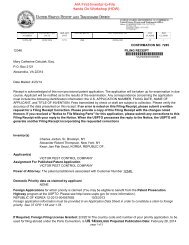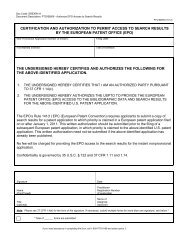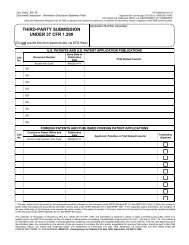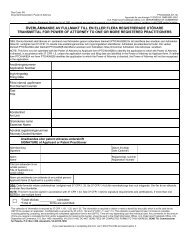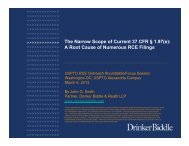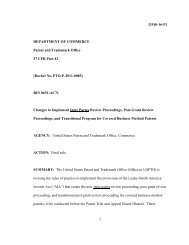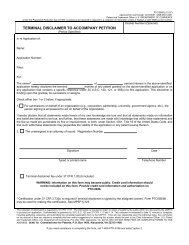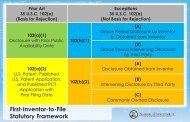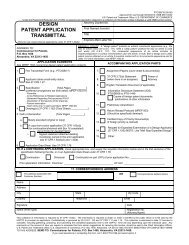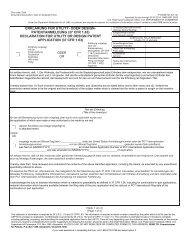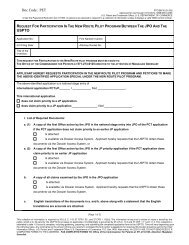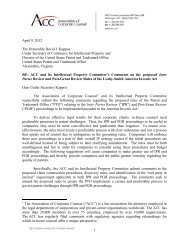From: MandT@mcglewtuttle.com - United States Patent and ...
From: MandT@mcglewtuttle.com - United States Patent and ...
From: MandT@mcglewtuttle.com - United States Patent and ...
You also want an ePaper? Increase the reach of your titles
YUMPU automatically turns print PDFs into web optimized ePapers that Google loves.
-----Original Message-----<br />
<strong>From</strong>: <strong>M<strong>and</strong>T@mcglewtuttle</strong>.<strong>com</strong> [mailto:<strong>M<strong>and</strong>T@mcglewtuttle</strong>.<strong>com</strong>]<br />
Sent: Tuesday, May 02, 2006 12:14 PM<br />
Subject: rule change <strong>com</strong>ments of John James McGlew<br />
Please find attached (pdf) the <strong>com</strong>ments for John James McGlew as to<br />
http://www.uspto.gov/web/offices/<strong>com</strong>/sol/notices/71fr48.pdf Changes to<br />
Practice for Continuing Applications, Requests for<br />
Continued Examination Practice, <strong>and</strong> Applications Containing <strong>Patent</strong>ably<br />
Indistinct Claims, Notice of proposed rule making<br />
McGlew <strong>and</strong> Tuttle, P.C.<br />
<strong>M<strong>and</strong>T@mcglewtuttle</strong>.<strong>com</strong><br />
Tel: (914) 941-5600<br />
Fax: (914) 941-5855<br />
www.mcglewtuttle.<strong>com</strong>
DEPARTMENT OF COMMERCE<br />
<strong>Patent</strong> <strong>and</strong> Trademark Office<br />
37 CFR Part 1<br />
[Docket No.: 2005–P–066]<br />
RIN 0651–AB93<br />
Changes To Practice for Continuing Applications, Requests for Continued<br />
Examination Practice, <strong>and</strong> Applications Containing <strong>Patent</strong>ably Indistinct Claims<br />
COMMENTS SUBMITTED BY JOHN JAMES MCGLEW<br />
The USPTO is responding to the apparent difficulty in providing quality examination at<br />
the rate applications are being filed. The solution proposed attempts to limit examination by<br />
limiting continuation applications <strong>and</strong> requests for continuing examination (RCE). The rationale<br />
for this is based on considering each application examined as a unit with the rule forcing less<br />
application units. However, the USPTO does not provide any basis for the unit approach.<br />
Individuals that are involved in prosecution consider the work on such continuations to be a<br />
fraction of the work involved with new applications. The concept that each continuation<br />
examined can be replaced with an examination of a new patent application is clearly flawed.<br />
However, the deeper problem is that no one, including the USPTO, can predict the effect such<br />
changes will have on overall work <strong>and</strong> overall costs. Since such continuations serve a purpose,<br />
one can conclude that if the existing continuation practice is ended, the quality of the overall<br />
product will be affected negatively.<br />
As many aspects of patent prosecution are interrelated, changes to continuation practice<br />
will affect other things. More new applications could be filed. The changes could result in<br />
claims being drafted seeking a restriction requirement. Petitions regarding whether claims are<br />
patentably distinct could increase drastically. Many more cases may be appealed. Some cases<br />
may be appealed simply to preserve pendency. The applicant may be forced to appeal instead of<br />
accepting coverage, instead of working further with the examiner in a continuation or RCE.<br />
Possibly, the rules will lead to situations with an appeal on the original application <strong>and</strong> an appeal<br />
on the first <strong>and</strong> only continuation application. A great deal of resources may be used for<br />
considering ancillary issues, examination problems, <strong>and</strong> petitions. The solution proposed may<br />
well raise the overall operating costs of the USPTO.<br />
The proposal takes away continuation practice without taking away the practice of finally<br />
rejecting claims based on a new ground of rejection (that can include previously unknown prior<br />
art). Compact prosecution allows the USPTO to make rejections final that are a first rejection,<br />
namely a new ground of rejection. The applicant has always been given the opportunity to<br />
amend the claims in response to a final rejection that is a new rejection. Making a new rejection<br />
<strong>and</strong> not allowing further amendments is not a viable system. Further, the new rules present an<br />
opportunity for abuse <strong>and</strong> potentially unfair results. At the very least, if the rule change is<br />
adopted, the USPTO should change its guidelines so that no rejection may be made final that is<br />
based on a new ground of rejection.<br />
The proposed rules do shift resources from an area of expertise, namely examination, to<br />
an area of fact finding <strong>and</strong> ruling on non substantive issues. The USPTO has in the past noted it
is not equipped to properly h<strong>and</strong>le fact inquires. The USPTO has noted it has expertise in prior<br />
art evaluation <strong>and</strong> examination on the merits. The administrative burden on the USPTO as to<br />
decisions on form <strong>and</strong> fact issues, such as petitions, has grown over the years. The proposed<br />
rules effectively add further matters to be decided on petition, effectively shifting resources from<br />
an area of expertise to an area the USPTO has in the past admitted, it is not equipped to h<strong>and</strong>le.<br />
The USPTO should move in the opposite direction, limiting matters of form <strong>and</strong> limiting<br />
petitionable matters. The focus must be on building up the Examining Corps <strong>and</strong> more <strong>and</strong><br />
better examination on the merits with simple examination procedures.<br />
To allow new applications to be picked up more quickly, the USPTO could give priority<br />
toward examination of new applications. Examination Groups could be given the latitude to pick<br />
up RCEs or continuations in a delayed manner. This could be linked to how many continuations<br />
have already been filed (e.g., a third continuation or RCE could be queued for examination after<br />
new applications filed at the same time). Instead of focusing on building up the Examining<br />
Corps, the proposed changes essentially seek to limit the depth <strong>and</strong> extent of prosecution <strong>and</strong><br />
examination. Resources should be directed toward examination. If the out<strong>com</strong>e of the change is<br />
not certain, as is the case, the USPTO should not deflect its resources away from maintaining a<br />
solid Examining Corps. A good Examining Corps is a national resource. If the new application<br />
backlog is growing, the USPTO has faced this problem before. The traditional approach of<br />
growing the USPTO <strong>and</strong> building up the Examining Corps provides more certainty than rationing<br />
examination.<br />
It could be said that besides the growing backlog of cases, there is another linked<br />
problem, namely political pressure focused on numbers rather than quality of examination. This<br />
is particularly a problem with there being no link between revenue from fees <strong>and</strong> the funds<br />
available to maintain the Examining Corps. The real thing that needs to be changed is to hire <strong>and</strong><br />
train more Examiners <strong>and</strong> to make the USPTO a place where technically trained people want to<br />
work. Examiners must feel that there is a significant purpose to what they do <strong>and</strong> be rewarded<br />
financially <strong>and</strong> by a sense of job well ac<strong>com</strong>plished. The staggering rate at which Examiners<br />
have left in recent years points to not only a problem of pay but also of work environment.<br />
The rules should not be changed as proposed. The USPTO proposal is too drastic with<br />
the result unknown. The USPTO needs to be patient. New technologies should still have a<br />
significant positive impact on costs <strong>and</strong> efficiency, as new systems be<strong>com</strong>e more familiar. With<br />
electronic filing now more user friendly, there will be time savings for the USPTO <strong>and</strong> the<br />
applicants. Foreign office searches can never be given full faith <strong>and</strong> credit (because of law<br />
differences <strong>and</strong> claim differences). However, systems that present the US examiner with all prior<br />
art considered in related matters will have a positive effect as to efficiency. Shrinking <strong>and</strong><br />
stabilizing the backlog is possible. More resources should be directed now toward the<br />
Examining Corps.<br />
John James McGlew<br />
Registered <strong>Patent</strong> Attorney<br />
McGlew <strong>and</strong> Tuttle, P.C.<br />
Scarborough, New York


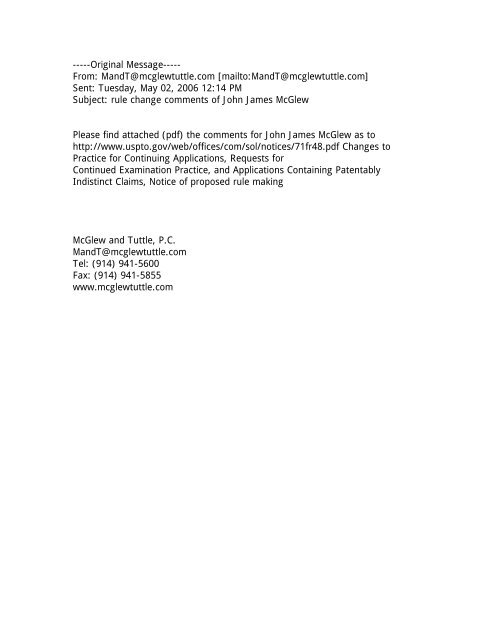
![Printable version [PDF] - United States Patent and Trademark Office](https://img.yumpu.com/51835259/1/184x260/printable-version-pdf-united-states-patent-and-trademark-office.jpg?quality=85)
